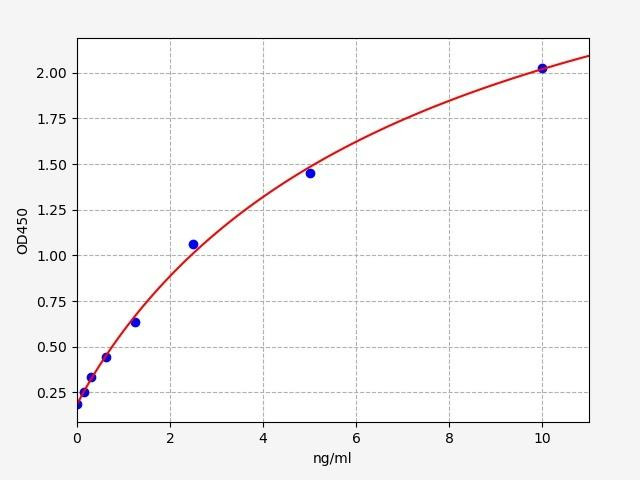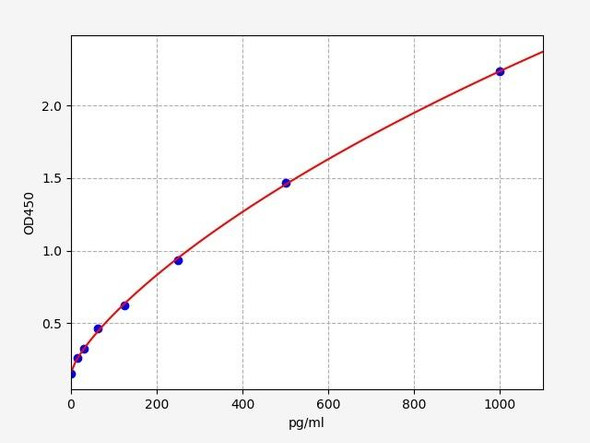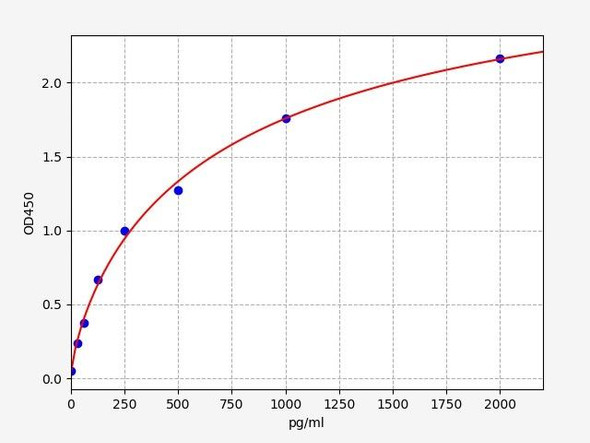Human Urocortin-3 ELISA Kit
- SKU:
- HUFI00509
- Product Type:
- ELISA Kit
- Size:
- 96 Assays
- Uniprot:
- Q969E3
- Sensitivity:
- 0.094ng/ml
- Range:
- 0.156-10ng/ml
- ELISA Type:
- Sandwich
- Synonyms:
- UCN3, Urocortin-3, Stresscopin, Urocortin III, Ucn III,
- Reactivity:
- Human
Description
Human Urocortin-3 ELISA
Urocortin-3 preproprotein is proteolytically processed to generate the mature peptide hormone, which is secreted by pancreatic beta and alpha cells. Urocortin-3 is an endogenous ligand for corticotropin-releasing factor receptor 2. Urocortin-3 may regulate insulin secretion in response to plasma glucose levels. Urocortin-3 may be responsible for the effects of stress on appetite, and reduced Urocortin-3 levels have been associated with type 2 diabetes.
Key Features
| Save Time | Pre-coated 96 well plate | |
| Quick Start | Kit includes all necessary reagents | |
| Publication Ready | Reproducible and reliable results |
Overview
| Product Name: | Human Urocortin-3 ELISA Kit |
| Product Code: | HUFI00509 |
| Size: | 96 Assays |
| Alias: | UCN3, Urocortin-3, Stresscopin, Urocortin III, Ucn III |
| Detection Method: | Sandwich ELISA, Double Antibody |
| Application: | This immunoassay kit allows for the in vitro quantitative determination of Human UCN3 concentrations in serum plasma and other biological fluids. |
| Sensitivity: | 0.094ng/ml |
| Range: | 0.156-10ng/ml |
| Storage: | 4°C for 6 months |
| Note: | For Research Use Only |
Additional Information
| Recovery | Matrices listed below were spiked with certain level of Human UCN3 and the recovery rates were calculated by comparing the measured value to the expected amount of Human UCN3 in samples.
| ||||||||||||||||||||
| Linearity: | The linearity of the kit was assayed by testing samples spiked with appropriate concentration of Human UCN3 and their serial dilutions. The results were demonstrated by the percentage of calculated concentration to the expected.
| ||||||||||||||||||||
| CV (%) | Intra-Assay: CV<8% |
Kit Components
| Component | Quantity | Storage |
| ELISA Microplate (Dismountable) | 8x12 strips | 4°C for 6 months |
| Lyophilized Standard | 2 | 4°C/ -20°C |
| Sample/Standard Dlution Buffer | 20ml | 4°C |
| Biotin-labeled Antibody (Concentrated) | 120ul | 4°C (Protection from light) |
| Antibody Dilution Buffer | 10ml | 4°C |
| HRP-Streptavidin Conjugate (SABC) | 120ul | 4°C (Protect from light) |
| SABC Dilution Buffer | 10ml | 4°C |
| TMB Substrate | 10ml | 4°C (Protection from light) |
| Stop Solution | 10ml | 4°C |
| Wash Buffer (25X) | 30ml | 4°C |
| Plate Sealer | 5 | - |
Other materials required:
- Microplate reader with 450 nm wavelength filter
- Multichannel Pipette, Pipette, microcentrifuge tubes and disposable pipette tips
- Incubator
- Deionized or distilled water
- Absorbent paper
- Buffer resevoir
Protocol
*Note: Protocols are specific to each batch/lot. For the exact instructions please follow the protocol included in your kit.
Before adding to wells, equilibrate the SABC working solution and TMB substrate for at least 30 min at 37°C. When diluting samples and reagents, they must be mixed completely and evenly. It is recommended to plot a standard curve for each test.
| Step | Procedure |
| 1. | Set standard, test sample and control (zero) wells on the pre-coated plate respectively, and then, record their positions. It is recommended to measure each standard and sample in duplicate. Wash plate 2 times before adding standard, sample and control (zero) wells! |
| 2. | Aliquot 0.1ml standard solutions into the standard wells. |
| 3. | Add 0.1 ml of Sample / Standard dilution buffer into the control (zero) well. |
| 4. | Add 0.1 ml of properly diluted sample ( Human serum, plasma, tissue homogenates and other biological fluids.) into test sample wells. |
| 5. | Seal the plate with a cover and incubate at 37 °C for 90 min. |
| 6. | Remove the cover and discard the plate content, clap the plate on the absorbent filter papers or other absorbent material. Do NOT let the wells completely dry at any time. Wash plate X2. |
| 7. | Add 0.1 ml of Biotin- detection antibody working solution into the above wells (standard, test sample & zero wells). Add the solution at the bottom of each well without touching the side wall. |
| 8. | Seal the plate with a cover and incubate at 37°C for 60 min. |
| 9. | Remove the cover, and wash plate 3 times with Wash buffer. Let wash buffer rest in wells for 1 min between each wash. |
| 10. | Add 0.1 ml of SABC working solution into each well, cover the plate and incubate at 37°C for 30 min. |
| 11. | Remove the cover and wash plate 5 times with Wash buffer, and each time let the wash buffer stay in the wells for 1-2 min. |
| 12. | Add 90 µl of TMB substrate into each well, cover the plate and incubate at 37°C in dark within 10-20 min. (Note: This incubation time is for reference use only, the optimal time should be determined by end user.) And the shades of blue can be seen in the first 3-4 wells (with most concentrated standard solutions), the other wells show no obvious color. |
| 13. | Add 50 µl of Stop solution into each well and mix thoroughly. The color changes into yellow immediately. |
| 14. | Read the O.D. absorbance at 450 nm in a microplate reader immediately after adding the stop solution. |
Sample Preparation
When carrying out an ELISA assay it is important to prepare your samples in order to achieve the best possible results. Below we have a list of procedures for the preparation of samples for different sample types.
| Sample Type | Protocol |
| Serum | If using serum separator tubes, allow samples to clot for 30 minutes at room temperature. Centrifuge for 10 minutes at 1,000x g. Collect the serum fraction and assay promptly or aliquot and store the samples at -80°C. Avoid multiple freeze-thaw cycles. If serum separator tubes are not being used, allow samples to clot overnight at 2-8°C. Centrifuge for 10 minutes at 1,000x g. Remove serum and assay promptly or aliquot and store the samples at -80°C. Avoid multiple freeze-thaw cycles. |
| Plasma | Collect plasma using EDTA or heparin as an anticoagulant. Centrifuge samples at 4°C for 15 mins at 1000 × g within 30 mins of collection. Collect the plasma fraction and assay promptly or aliquot and store the samples at -80°C. Avoid multiple freeze-thaw cycles. Note: Over haemolysed samples are not suitable for use with this kit. |
| Urine & Cerebrospinal Fluid | Collect the urine (mid-stream) in a sterile container, centrifuge for 20 mins at 2000-3000 rpm. Remove supernatant and assay immediately. If any precipitation is detected, repeat the centrifugation step. A similar protocol can be used for cerebrospinal fluid. |
| Cell culture supernatant | Collect the cell culture media by pipette, followed by centrifugation at 4°C for 20 mins at 1500 rpm. Collect the clear supernatant and assay immediately. |
| Cell lysates | Solubilize cells in lysis buffer and allow to sit on ice for 30 minutes. Centrifuge tubes at 14,000 x g for 5 minutes to remove insoluble material. Aliquot the supernatant into a new tube and discard the remaining whole cell extract. Quantify total protein concentration using a total protein assay. Assay immediately or aliquot and store at ≤ -20 °C. |
| Tissue homogenates | The preparation of tissue homogenates will vary depending upon tissue type. Rinse tissue with 1X PBS to remove excess blood & homogenize in 20ml of 1X PBS (including protease inhibitors) and store overnight at ≤ -20°C. Two freeze-thaw cycles are required to break the cell membranes. To further disrupt the cell membranes you can sonicate the samples. Centrifuge homogenates for 5 mins at 5000xg. Remove the supernatant and assay immediately or aliquot and store at -20°C or -80°C. |
| Tissue lysates | Rinse tissue with PBS, cut into 1-2 mm pieces, and homogenize with a tissue homogenizer in PBS. Add an equal volume of RIPA buffer containing protease inhibitors and lyse tissues at room temperature for 30 minutes with gentle agitation. Centrifuge to remove debris. Quantify total protein concentration using a total protein assay. Assay immediately or aliquot and store at ≤ -20 °C |
| Breast Milk | Collect milk samples and centrifuge at 10,000 x g for 60 min at 4°C. Aliquot the supernatant and assay. For long term use, store samples at -80°C. Minimize freeze/thaw cycles. |
Human UCN3 Background
Human UCN3 Gene
The UCN3 is a protein coding gene that codes for the Urocortin 3/Stresscopin protein from the sauvagine/urotensin I/corticotropin-releasing factor (CRF) Family of proteins. The gene is structurally related to the corticotropin-releasing factor (CRF) gene and the encoded product is an endogenous ligand for CRF type 2 receptors
Human UCN3 Protein
The human urocortin3 , also known as stresscopin, is a peptide hormone found in humans. It is initially produced as a larger preproprotein, and then undergoes proteolytic processing to yield the mature peptide hormone. Secreted by both pancreatic beta and alpha cells, It functions as an endogenous ligand, binding specifically to the corticotropin-releasing factor receptor 2 (CRFR2). Activation of CRF2 receptors triggers a cascade of intracellular signaling events, leading to the modulation of several physiological processes.
Human Urocortin 3 peptide. Source: Uniprot
Function and Significance in Disease
The Urocortin 3 hormone exhibits potential involvement in regulating insulin secretion in response to plasma glucose levels. Interestingly, individuals diagnosed with type 2 diabetes often exhibit reduced levels of this encoded protein within their beta cells. Furthermore, within the brain, this encoded protein may be responsible for mediating the impact of stress on appetite regulation. According to Uniprot, the protein is involved in Suppressing food intake, delaying gastric emptying and decreasing heat-induced edema and it might represent an endogenous ligand for maintaining homeostasis after stress.
These observations indicate the potential significance of this protein in the context of metabolic control and the physiological response to stress. It has been investigated for its involvement in various disorders, including anxiety, depression, cardiovascular diseases, and metabolic disorders. Understanding the precise mechanisms and functions of urocortin 3 may lead to the development of targeted therapies for these conditions.
UCN 3 Fact Sheet
Human UCN3 ELISA FAQs
Q: What is the Human Urocortin-3 ELISA Kit used for?
The Human Urocortin-3 Sandwich ELISA Kit is a specialized tool designed for the quantitative measurement of human Urocortin-3 levels in biological samples. It enables researchers and clinicians to investigate the presence and concentration of Urocortin-3, a peptide hormone associated with various physiological and pathological conditions.
Q: What type of samples can be used with this kit??
The Human Urocortin-3 Sandwich ELISA Kit is designed to measure Urocortin-3 levels in various human biological liquid samples, including serum and plasma. It is important to follow the recommended sample preparation guidelines outlined in the kit manual for optimal results.
Q: Can the kit be used with samples from species other than humans?
The Human Urocortin-3 Sandwich ELISA Kit is specifically optimized for the quantitative measurement of Urocortin-3 in human samples. While it may exhibit some cross-reactivity with Urocortin-3 from other species, its performance and accuracy cannot be guaranteed. For non-human samples, researchers should consider using a species-specific ELISA kit for accurate results.
Q: Where can I find additional technical support or assistance with the UCN3 ELISA kit?
For any technical inquiries or assistance regarding the UNC13A ELISA kit, you can reach out to our team. They will be available to answer your questions and provide the necessary guidance to ensure a successful experiment.
Related Products

| Human Corticotropin Releasing Hormone (CRH) ELISA | |
|---|---|
| ELISA TYPE: | Competitive ELISA, Coated with Antigen |
| SENSITIVITY: | 1.4pg/ml |
| RANGE: | 2.188-140pg/ml |
This ELISA kit enables researchers to quantify CRH levels in human samples, allowing for investigations into the role of CRH in stress response, mood disorders, and neuroendocrine regulation.

| Human Insulin ELISA | |
|---|---|
| ELISA TYPE: | Sandwich ELISA, Double Antibody |
| SENSITIVITY: | 0.094ng/ml |
| RANGE: | 0.156-10ng/ml |
The Human Insulin ELISA Kit facilitates the measurement of insulin levels in human samples, aiding research on diabetes, metabolic disorders, and insulin resistance.

| Human Glucocorticoid Receptor Alpha ELISA | |
|---|---|
| ELISA TYPE: | Sandwich ELISA, Double Antibody |
| SENSITIVITY: | 0.188ng/ml |
| RANGE: | 0.313-20ng/ml |
This ELISA kit allows for the quantitative assessment of GR levels in human samples, supporting studies on stress response, inflammatory processes, and endocrine signaling pathways.










